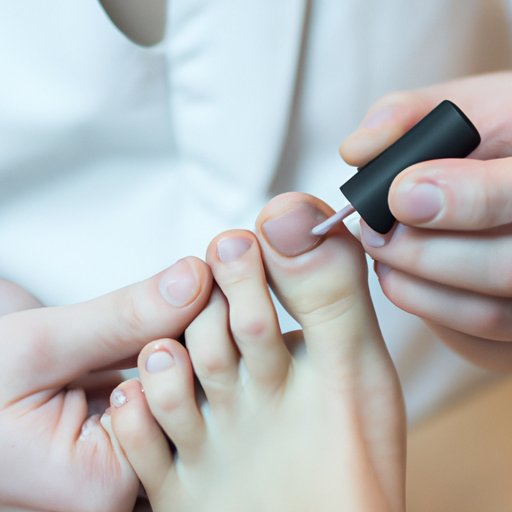
Introduction
If you’ve ever had an ingrown toenail, you know the pain and discomfort it can cause. Ingrown toenails occur when the edge of the nail grows into the skin, causing redness, swelling, and pain. They are most common in the big toes and can be caused by many factors, including improper nail trimming, tight-fitting shoes, injury, and genetics.
It’s important to properly address ingrown toenails to avoid infection and further complications. This article will provide you with a complete guide to removing an ingrown toenail at home, natural remedies to try, when to seek medical attention, tips for preventing ingrown toenails, and my personal experience with the issue.
The Complete Guide to Removing an Ingrown Toenail at Home
If you’re experiencing an ingrown toenail and want to try removing it at home, follow these step-by-step instructions:
- Soak your foot in warm water for 15-20 minutes to soften the nail and skin.
- Gently lift the edge of the ingrown nail using a cotton swab or dental floss.
- Cut the edge of the nail straight across, avoiding cutting it too short or rounding the corners.
- Avoid pulling the nail out completely, as it may cause further damage.
- Apply an antiseptic and a sterile bandage to the affected toe.
It’s important to take some precautions before attempting to remove an ingrown toenail at home:
- Make sure your hands and equipment are clean to avoid infection.
- Do not attempt to remove an ingrown toenail if you have an underlying medical condition, such as diabetes or a compromised immune system.
- If the pain or infection worsens, seek medical attention.
After removing an ingrown toenail at home, follow these post-procedure care instructions:
- Change the bandage daily and apply any prescribed medication.
- Avoid wearing tight-fitting shoes, as they may cause further discomfort and ingrown toenails.
- Continue soaking your foot in warm water with Epsom salts to promote healing.
Natural Remedies for Ingrown Toenail Removal
If you’re looking for natural remedies to remove an ingrown toenail, you may want to try the following:
- Tea tree oil: Apply a few drops of tea tree oil to the affected area daily to reduce inflammation and fight infection.
- Apple cider vinegar: Soak your foot in a mixture of warm water and apple cider vinegar for 20-30 minutes daily to help soften the nail and skin.
- Epsom salts: Add Epsom salts to warm water and soak your foot for 15-20 minutes to help relieve pain and reduce inflammation.
- Essential oils: Apply a few drops of lavender or peppermint oil to the affected toe to help relieve pain and inflammation.
- Cotton ball method: Place a small piece of cotton under the edge of the ingrown nail to lift it and promote growth away from the skin.
Keep in mind that natural remedies may not work for everyone and it’s important to take precautions when using them:
- Stop using the remedy if it causes irritation or an allergic reaction.
- Consult with a doctor before using natural remedies if you have an underlying medical condition or are pregnant or breastfeeding.
- If the pain or infection worsens, seek medical attention.
When to See a Doctor for an Ingrown Toenail
If your ingrown toenail is causing severe pain, redness, swelling, or infection, it’s important to seek medical attention. A doctor can provide treatment options, such as antibiotics for infection or nail removal surgery if necessary.
Before your doctor’s appointment, be prepared by:
- Keeping track of your symptoms and when they started.
- Bringing a list of any medications or supplements you’re taking.
- Removing any nail polish or decorations from the affected toe.
A medical exam may include:
- Visual inspection of the affected toe.
- X-rays to check for bone involvement or damage.
- Nail removal or trimming under local anesthesia.
Preventing Ingrown Toenails: Tips for Healthy Feet
The best way to address ingrown toenails is to prevent them from occurring in the first place. Follow these tips to maintain healthy feet:
- Trim your nails straight across, avoiding rounding the corners.
- Avoid wearing tight-fitting shoes or socks that may cause toenail pressure.
- Wear shoes that fit properly, allowing room for toes to move.
- Keep your feet dry and clean to prevent infection.
- Keep your toenails at a moderate length.
Remember, taking care of your feet is important throughout life to avoid ingrown toenails and other foot issues.
Ingrown Toenails: My Personal Experience
As someone who has experienced ingrown toenails in the past, I understand the pain and discomfort they can cause. After trying various remedies and techniques, I found that proper nail trimming and wearing comfortable shoes were the best solutions for me. I encourage readers to address ingrown toenails early on and take steps to prevent them from occurring in the future.
Conclusion
Ingrown toenails can be painful and uncomfortable, but there are ways to address them at home and prevent them from occurring in the future. Whether you try natural remedies, consult with a doctor, or take preventive measures, it’s important to prioritize foot health to avoid complications. Remember to seek medical attention if the pain or infection worsens and don’t hesitate to take action to address ingrown toenails.





